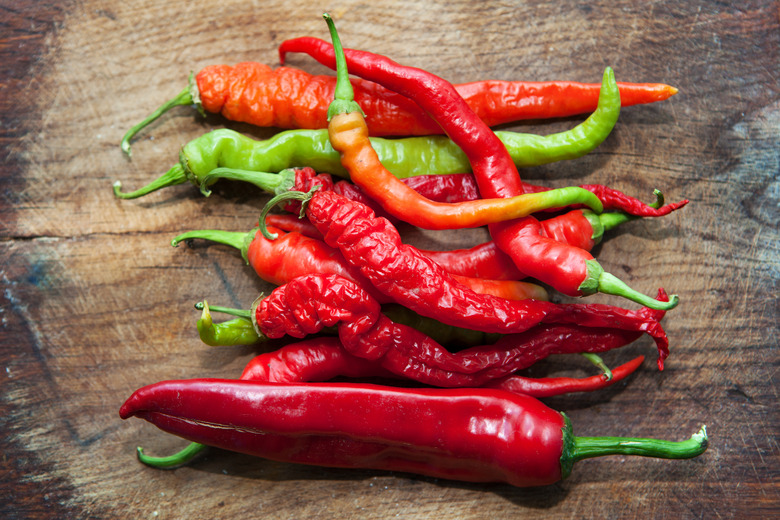How To Make Pure Capsaicin
The compound that gives peppers — the fruits of plants in the genus Capsicum — their spicy or hot (piquant) flavor is capsaicin. In mammals, capsaicin is a chemical irritant, which produces a sensation of burning, especially in mucous membranes like the mouth, eyes and nose. This irritating sensation from contact with capsaicin is not felt by birds, the main animals responsible for dispersing pepper seeds in nature.
Capsaicin has a number of uses. As an additive in topical creams and ointments, it has a pain-relieving effect, and it helps with conditions such as rheumatoid arthritis and osteoarthritis. Since it is only effective on mammals, it is a good pest deterrent. Gardeners use it to protect crops and gardens, as well as birdseed from animals like rodents. It is also the active ingredient in pepper spray and bear spray, both of which people used in self defense. While you cannot extract totally pure capsaicin at home, with a few short steps and some basic supplies, it is possible to extract something close to the real deal from chili peppers.
Things Needed
- Spicy peppers
- A coffee grinder, spice grinder, blender or a mortar and pestle
- Protective vinyl gloves
- Face mask
- Safety glasses
- A glass canning jar with a seal
- Anhydrous, or pure ethanol
- Cheesecloth or coffee filters
- A shallow pan or bowl
1. Select the Correct Peppers
Select the best peppers to extract capsaicin by choosing peppers that contain the highest concentrations of it. The "heat" of peppers is measured in a what are called Scoville Heat Units. The higher the SHU number, the spicier the pepper. Peppers with a high concentration of capsaicin — and a high SHU — generally rank between 500,000 and 3,200,000 SHU. Examples of these super-spicy cultivars include Bhut Jolokia, Carolina Reaper, Red Savina, Trinidad Moruga Scorpion, Pepper X, Dragon's Breath and Naga Morich.
2. Drying the Peppers
Lay out the peppers to dry completely and naturally over the course of a few weeks, in an oven or dehydrator. You can avoid this step by purchasing peppers already dried.
3. Select Specific Parts of the Pepper for Extraction
Choose the best parts of the pepper. Capsaicin is highly concentrated in the white pith that surrounds the seed, as well as the other interior membranes of the pepper fruit. It is also present in the flesh of the fruit, but not very concentrated in the stems and green tissues. The best parts of the pepper to use includes everything below the stem.
4. Grind the Peppers
Grind the peppers, seeds and all, into a fine powder using a hand grinder, an electric spice or coffee one, a blender or by pulverizing the peppers into a powder using a mortar and pestle. Put on the protective rubber gloves, safety glasses and a mask over the face and nose during this part, as inhaling peppers can irritate the nose and lungs, and wash the chosen grinder or other equipment thoroughly with soap after use to prevent a nasty spicy surprise the next time you use them. Pulverizing the dried peppers increases its surface area, making the next step faster and more effective.
5. Extract the Capsaicin
Add the pulverized peppers to a canning jar that you can seal. Pour enough anhydrous pure ethanol over the powdered peppers to cover them completely, and then some, before sealing the jar. Let the soaked pepper powder sit in the jar from three days to a week. After they have soaked enough, place the cheesecloth or a coffee over a pan or bowl to filter the and get rid of the pepper bits and sediment, leaving only a liquid.
6. Boil the Liquid
Boil the remaining liquid, which is a combination of alcohol, capsaicin and capsaicin-like compounds called capsaicinoids, at a low temperature or leave it to evaporate in a shallow pan. The results after evaporation or boiling is an almost pure form of capsaicin. Wear gloves and a face mask when handling this substance, as it can cause injury to humans and other mammals.
Warning
Pure capsaicin is a highly irritating compound, and can be dangerous when it comes into contact with mucous membranes such as the eyes, nose, mouth and lungs. Always wear protective gloves, a mask over the nose and mouth and glasses when working with chili peppers and capsaicin.
Cite This Article
MLA
Grosfield, Lynsey. "How To Make Pure Capsaicin" sciencing.com, https://www.sciencing.com/make-pure-capsaicin-7826415/. 11 April 2018.
APA
Grosfield, Lynsey. (2018, April 11). How To Make Pure Capsaicin. sciencing.com. Retrieved from https://www.sciencing.com/make-pure-capsaicin-7826415/
Chicago
Grosfield, Lynsey. How To Make Pure Capsaicin last modified March 24, 2022. https://www.sciencing.com/make-pure-capsaicin-7826415/
